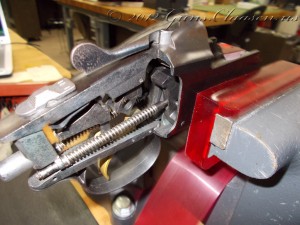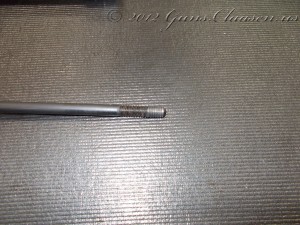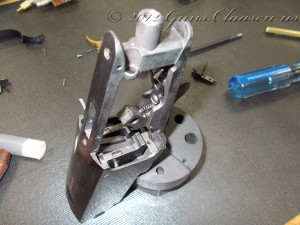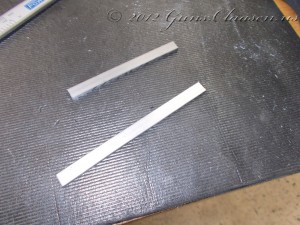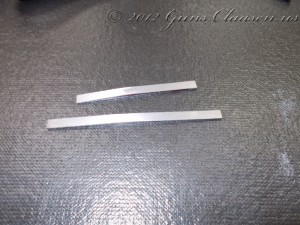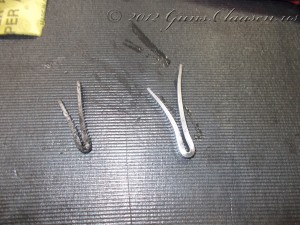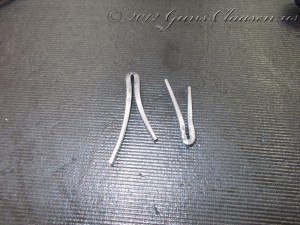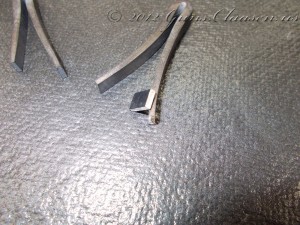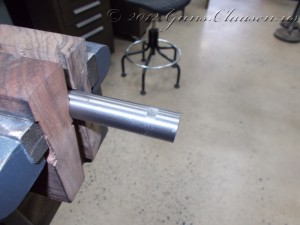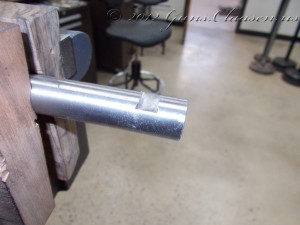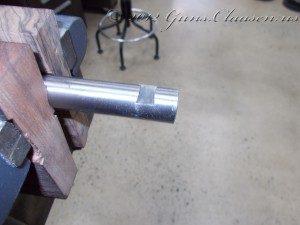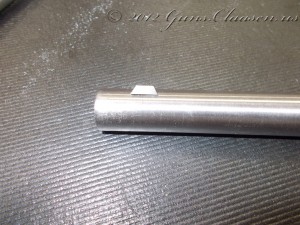Gunsmithing
 Stoeger Condor
Stoeger Condor
The first of the four repairs I performed this semester was on a Stoeger Condor O/U. The second barrel would not fire reliably. This was an intermittent problem which is always difficult to diagnose. On disassembly, I found the following:
At first glance, everything seemed to be good with no obvious fault in the firing system.
The stock bolt showed signs of cross threading. This was repaired as a loose stock can lead to damage on recoil.
On disassembly of the firing system, I did find that the screw holding the safety detent spring was not tightened properly. Looking at the operation of the firearm, it is possible that this could cause an intermittent problem when firing the second barrel. I tightened the screw, cleaned the firearm, and test fired it with no malfunctions.
 L.C. Smith springs
L.C. Smith springs
One of the skills a gunsmith needs to have is to know how to make replacement parts for firearms. Very often, the repair is on a firearm that does not have replacement parts available. The requirement for this course is to make a mainspring and a bolt spring for an L. C. Smith shotgun. The springs are made from blank spring stock and cut to size.
The next step is to shape the springs.
Once the desired shape for the springs is achieved, the springs are heated and bent to the correct shape. Notice the curves in the legs of the springs.
The springs are then cleaned and tempered in our oven. This can also be done by using any heat source, but care has to be taken not to heat the spring too much as it will become brittle and be prone to breaking.
After coming out of the oven (and cooled down) the springs can be tested. This is merely done by compressing them in a vice. If the do not break and return to their original shape, all is fine. Mine passed the test, even though one of the legs on the mainspring broke. After discussing it with the instructor, we felt that it was most likely due to a small stress fracture in the spring material.
 2013
2013
What a busy beginning to the new year. After spending a little more than two weeks in South Africa over Christmas, I arrived back in the USA on New Years day. But I would not have much rest before our semester start on Jan 7 as I flew to Dallas on the 2nd to attend the Dallas Safari Club/American Custom Gunmakers Guild 2013 meeting, together with a group of MCC gunsmithing students. This was the first time the ACCG was displaying in conjunction with DSC. It was truly an experience to see the high quality of work that the ACCG members had on display. The show also gave us the opportunity to speak to and pick the brains of ACCG members which was very educational. The DSC show was also a very worthwhile experience as there were many manufacturers of fine firearms with booths such as Fausti, Rigby and O’Farril Shirley to name a few. Rigby had one of their gunsmiths on hand and he actually performed some work in their booth and answered any questions about his work and techniques. Another highlight of the show was the opportunity to attend the ACCG banquet on Saturday night. Personally, I was also honored to receive a scholarship from ACCG during their annual meeting on Friday morning.
My thanks goes to ACCG for not only the monetary award, but also the high regard they have for the potential of my work. Since I am busy thanking people, I should also thank Pete Brownell of Brownells for helping defray the cost of the ACCG banquet for myself and all the students of gunsmithing schools that was in attendance at the meeting. Finally, I have to thank my good friend Sydney for the donation of air-miles that helped get to and from Dallas. I am grateful for the help from all of you.
Back in North Carolina, and back into the start of a new semester. This is the 5th of six and is going to be a very busy one.
Friday means I am back on an aircraft, this time heading for Las Vegas and SHOT show 2013. This is the largest trade show of its kind in the world with over 600000 square feet of exhibits and more than 60000 attendees. It is only open to the industry. All the major manufacturers attend and this is an excellent opportunity for networking and learning more about the firearms industry. Most of the suppliers that gunsmiths use also attend and it is a good opportunity to also thank them for their support of our program at MCC and to give them feedback on their product lines. At the end of the show, there were many sore feet but (for me at least) many new contacts made.
The trip to Las Vegas was also special for me this year as I was able to attend the American Pistolsmith Guild’s annual meeting and banquet. This came about as a result of a scholarship that they awarded me and I was publicly recognized as a winner during the meeting. Again, I am honored for the high regard that they viewed my potential.
 Dovetails
Dovetails
As most gunsmiths have access to a milling machine, they would normally use that to cut any dovetails. However, for this exercise we have to ours by hand. These are practice pieces intended to teach us how to do the work by hand if we need to. I used a pice of barrel that was cut from one of my projects and used that for this project. The dovetails are standard dovetail blanks that was purchased from Brownells. Here I am getting ready to start the first dovetail.
The first step is to cut or file the center portion of the cut down to depth.
Once I reached the required depth, I started the undercuts. These are done with a special triangular file cut to 60º with a “safe” edge. The safe edge is smooth and allows me to do the undercut without deepening the depth of the center cut.
This does take some time and eventually you will get to this point. The dovetail blank is now fitted in and checked for clearance. The rule is that there can be no daylight seen in the sides and bottom of the cut. In other words, the dovetail blank needs to fit the cut precisely.
The only step left is to install the blank and check the fitting and repeat it for a second dovetail.In the next picture you can see the completed barrel piece with both dovetails. Yes, I know that one was not installed square on the barrel but that was not a requirement in this project. I only needed to fit the dovetails.
